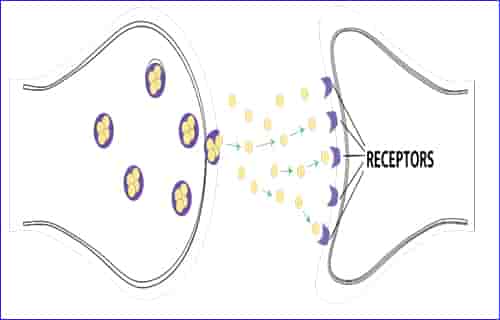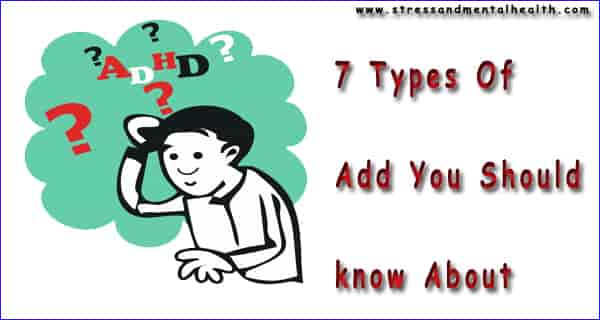“7 Types Of ADD You Should Know About: Attention-deficit/hyperactivity disorder (ADD) is a chronic condition including attention difficulty, hyperactivity, and impulsiveness. ADD started in childhood and remains into adulthood. It may contribute to low self-esteem, difficulty in maintaining relationships or friendships,s, and difficulty at school or work. “
How start Attention-deficit/hyperactivity disorder (ADD)?
The brain chemical dopamine may play an important role in attention-deficit/hyperactivity disorder. Dopamine is an important chemical that carries signals between nerves in the brain. Also, it is linked to many functions of the brain, such as mood, movement, sleep. Attention, learning, etc.
What part of the brain causes ADD?

Attention-deficit/hyperactivity disorder (ADD), normally crops up as a result of neurological dysfunction in the prefrontal cortex. When people suffering from Attention-deficit/hyperactivity disorder (ADD) try to concentrate, PFC activity decreases rather than increases as it does not in the normal brains of the control group subject.
What brain chemicals are missing in Attention-deficit/hyperactivity disorder (ADD)?
7 Types Of ADD You Should Know, It is due to deficiency of a specific neurotransmitter –norepinephrine- and it is the first disorder found to respond to medication to correct the deficiency. similar to all neurotransmitters, norepinephrine is produced within the brain.
How is ADD diagnosed?-Neuroimaging in Psychiatry
First of all, neuroimaging plays an important role for researchers, in the diagnosis of ADD. It is a helpful tool to evaluate the activity in the brain of various psychiatric conditions. However senior psychiatrists think that scans are good to evaluate the condition of the brain in Attention-deficit/hyperactivity disorder (ADD).
How many types of Attention-deficit/hyperactivity disorder (ADD)?
Attention-deficit/hyperactivity disorder (ADD) are of 7 types, such as
Type1 : Classic Attention-deficit/hyperactivity disorder (ADD)
Symptoms of classic ADD include, inattentive, distractible, disorganized, hyperactive, impulsive, and restless. In addition, People suffering from classic ADD have reduced blood flow in the brain area of the prefrontal cortex, cerebellum, and basal ganglia. Dopamine is produced in the brain with the help of ganglia.
Type 2 : Inattentive Attention deficit/hyperactivity disorder (ADD)?
Symptoms of inattentive ADD are inattentive and easily distracted, slow-moving, low motivation. But are not hyperactive. They are daydreamers and couch potatoes. This type of ADD is found mostly in girls in comparison to boys. Mostly diagnosed later in life, due to the reason that these people do not have behavior problems. People suffering from inattentive ADD have reduced activity in the prefrontal cortex as well as low levels of dopamine.
Type 3 : over-focused ADD
7 Types Of ADD You Should Know About, it includes classic ADD symptoms plus trouble shifting attention, frequently getting stuck in loops of negative thoughts or behavior, obsessive, excessive, worrying, inflexibility, argumentative behavior. It is due to a deficiency of dopamine and serotonin. The goal of the treatment is to increase both neurotransmitters
Type 4 : Temporal Lobe ADD
This type of patient includes classic ADD symptoms plus being irritable, quick-tempered, and aggressive, and having dark thoughts, unstable mood, learning and memory problems, visual changes. People have irregularities in the temporal lobes and less activity in the prefrontal cortex part of the brain.
Type 5 : Limbic ADD
This includes classic ADD symptoms plus chronic low-level sadness, but not depression, negativity, glass half empty syndrome, low energy. The patient feels worthlessness and hopelessness very frequently, feels low self-esteem. People suffering from Limbic ADD have excessive activity in the limbic section of the brain. The limbic section controls the mood. They have reduced activity in the prefrontal cortex both the time when focusing on a task or relaxing.
Type 6 : Ring of Fire ADD
It is the most extreme version of classic Attention-deficit/hyperactivity disorder (ADD), having additional symptoms of being extremely distractible, angry, irritable, overly sensitive to noise, light, clothes, and touch. These types of people are inflexible, extremely verbal, oppositional, and have cyclic moodiness. Their brain is overactive. The cerebral cortex and other areas of the brain contain an excess amount of activity.
Type 7 : Anxious ADD
Anxious Attention-deficit/hyperactivity disorder (ADD) includes classic ADD symptoms plus feeling anxious and tense. They feel physical stress symptoms such as headache or stomachache, feeling freezing, and anticipating the worst. People suffering from anxious ADD have a high level of activity in the basal ganglia and generate excess dopamine. Ganglia help the brain to generate dopamine. Only Anxious ADD patients generate dopamine chemicals in excess quantity. Whereas in all other ADD they produce reduced brain chemicals.
7 Types Of ADD You Should Know -Treatment
In all the Attention-deficit/hyperactivity disorder (ADD) treatment is required includes,
- Medication under the supervision of a specialist doctor of the respective field
- Supplements as per the advice of a specialist doctor., supplements also plays important role in the recovery of a patient.
- Regular exercise and morning walk
- Yoga in the supervision of an expert.
- Psychotherapy under the supervision of a psychologist.
- Now a days it is common that persons are suffering from more than one type of Attention deficit/hyperactivity disorder (ADD). Thus they are required to treat according to their conditions, symptoms, under the supervision of a medico specialist of the respective fields.
Frequently Asked Question about 7 Types Of ADD You Should Know About
Q. What is Attention-deficit/hyperactivity disorder (ADD)?
Ans. Attention-deficit/hyperactivity disorder (ADD) is a chronic condition including attention difficulty, hyperactivity, and impulsiveness.ADD started in childhood and remains into adulthood. It may contribute to low self-esteem, difficulty in maintaining relationships or friendships, and difficulty at school or work.
Q. What causes ADD?
Ans. The exact cause of attention-deficit/hyperactivity disorder (ADD) is not known but a number of factors are responsible such as genetic factors, environmental factors. The generation of brain chemicals is also responsible for these diseases.
Q. How does Attention-deficit/hyperactivity disorder (ADD) start?
Ans. The brain chemical dopamine may play an important role in attention-deficit/hyperactivity disorder. Dopamine is an important chemical that carries signals between nerves in the brain. Also, it is linked to many functions of the brain, such as mood, movement, sleep. Attention, learning, etc.
